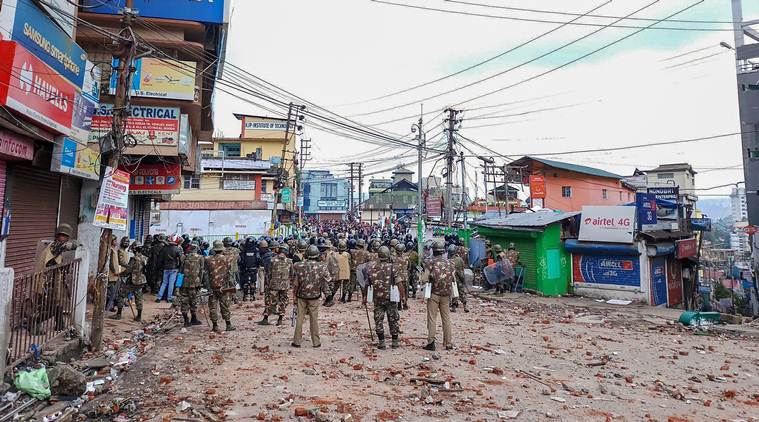
On Friday February 28, clashes broke out In Ichamati village located in the East Khasi Hills district of Meghalaya between members of the Khasi Students Union (KSU) and non-tribals. The violence took place at a rally against the Citizenship Amendment Act (CAA) where KSU, that opposes the CAA demanded the implementation of Inner Line Permit (ILP) at Ichamati. One member of the KSU identified as Lurshai Hynniewta, a resident of Khliehshnong Sohra, was killed in the clashes.
Thereafter, in a series of attacks non-tribal people, both Hindus and Muslims, were either killed or injured grievously: (Sources-India Express, Northeast News)
On Saturday, Rupchand Dewan, a vegetable vendor originally hailing from Assam’s Barpeta district was stabbed to death in Shillong’s Bara Bazar area
Another vegetable vendor Jaddu Choudhury from Silchar was also stabbed, but survived
Akash Ali from Barpeta, who works as a courier delivery boy was hit on the head with a hammer in Langsning on Saturday
Also, on Saturday, a member of Meghalaya Basin Development Authority was attacked in Mawthabah
A 28-year-old man identified as Aditya Kumar was stabbed at Mawprem and hospitalized with serious injuries
On Sunday, a 37-year-old man identified as Upas Uddin was killed in Pykran village that falls under the jurisdiction of Shella police station in Meghalaya’s East Khasi Hills district on Sunday morning. His three assailants are absconding and yet to be identified.
On Sunday morning, District Magistrate Matsiewdor W Nongbri said in an order, “There is a likelihood of a serious breakdown of peace and tranquillity which may lead to loss of life and property… I do promulgate curfew in these areas from 8 am on March 1 until further orders.”
Eight people have been arrested so far in connection with the attack that killed Hynniewta
Tribal group blames Hindutva groups, issues ultimatum to Bengali Hindus
The Hynniewtrep National Liberation Council (HNLC), a banned insurgent group from Meghalaya, has issued an ultimatum to all the Hindu-Bengalis to leave Ichamati and Majai areas at Shella in East Khasi Hills within one month. HNLC general secretary-cum-publicity secretary Sainkupar Nongtraw in a statement issued on Sunday said, “If they fail to do so by not complying to our ultimatum then we shall not be made responsible in case of any eventuality. This time it shall be a mass bloodshed.”
The HNLC blames Hindutva groups and Bengali Hindus for Lurshai Hynniewta’s death. “It was quite visible that the attacks were similar to the ones that happened in the country’s capital by Hindutva forces,” said the statement. “Whatever had happened in the country’s capital Delhi in the recent times was an outcome of the pro-CAA activists attacking the anti-CAA groups,” continued the statement, adding, “These incidents are all stage-managed by the Hindutva forces.”
Meghalaya’s ethnic make-up
The eastern state of Meghalaya is home to many tribes such as Khasi, Garo, Jaintia, Hajong, Biate, Tiwa (Lalung), Rabha, Kuki, Boro, Nepali, Karbi, Koch, Rajbongshi etc. In fact, till 1972 the state was a part of Assam, and the present-day state of Meghalaya was formed by carving out the Khasi, Garo and Jaintia Hills districts on January 21, 1972. According to the official website of the Meghalaya Tourism department, “Meghalaya’s main ethnic communities, each having its own distinctive customs and cultural traditions are the Khasis (of Mon-Khmer ancestry), the Garos (of Tibeto-Burman origin) and the Jaintias said to be from South East Asia.” Also, “The principal languages in Meghalaya are Khasi, Pnar and Garo with English as the official language of the State.”
According to census 2011 data, over three quarters of tribals practice Christianity. These include Garos and Khasis. However, tribes like Hajong, Koch and Rabha people are predominantly Hindu. Muslims account for less than five percent of the state’s population.
Anti-Bengali sentiment
In 1979, when the “anti-foreigner” sentiment swept across Assam, a parallel movement against Bengalis began in Meghalaya. The derogatory word Dkhar was used for ethnic Bengalis, who were mainly Hindu settlers. Ethnocentric Khasi organisations such as KSU and HNLC raised the slogan Beh Dkhar meaning chase the Dkhars away. Violence broke out in October 1979 after two Khasi boys allegedly desecrated an image of a Bengali Hindu deity. Bengali owned businesses and shops were subsequently shut down forcible and over 20,000 Bengalis were forced to flee the state.
Even today, Bengalis are viewed as outsiders and ethnocentric groups fear their influx will spoil the demography of the state. An HNCL statement released recently says that it fears that if “the CAA comes into its implementation then the Bengali Hindu community shall become the biggest threat to our Hynniewtrep land.”
Related:
Turmoil in the North East: The demand for Bangalistan
Turmoil in the North East: A Bru Story
Turmoil in the North East: The Naga Pact and its ramifications